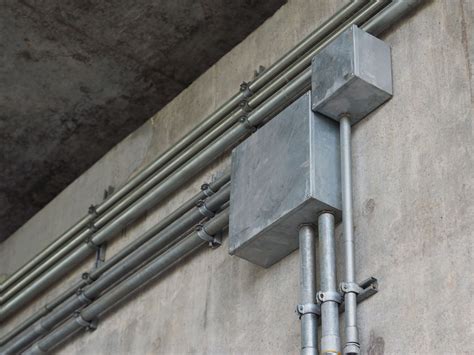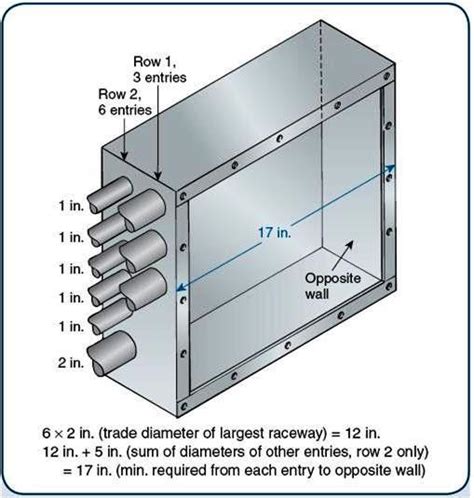electrical conduit between boxes of different sizes Tips For Bending Copper Pipe . Support the pipe: Support the copper pipe along the . Probably a utilitily valve/meter box. Those aren’t usually bolted shut. Usually on the curb, this is in the back yard, away from the house.
0 · underground electrical pull box sizes
1 · pull box standard sizes
2 · pull box sizing chart
3 · nec box sizing chart
4 · junction box sizes chart
5 · electrical pull box sizes
6 · electrical pull box size chart
7 · electrical box sizing chart
Still, it’s possible to weld thin sheet metal using the MIG (GMAW), TIG (GTAW), and stick (SMAW) processes. But MIG and TIG provide the best results. This article will teach you how to weld thin gauge metal using each arc welding process and present the common pitfalls beginners make.
Understand the different types of electrical conduit, including common types, rigid vs. flexible tubing, grounding boxes, what wiring to use, and why.

metal junction box with terminals
Tips For Bending Copper Pipe . Support the pipe: Support the copper pipe along the .While electrical boxes have many variations, they all fall into one of two .The four main rules of electrical wiring are: use the right gauge of wire for the .

underground electrical pull box sizes
The National Electrical Code has specific regulations for how many conductor .Electrical boxes encase wire connections to protect them from short circuits. They .
Learn all about the different types of electrical conduit including use cases. An electrical conduit is a tube in which electrical wires are housed for a .Conduit junction boxes are made from a variety of materials, including metal and plastic, and they come in different types and sizes to suit specific needs. Let’s explore these aspects in more detail. The most common type is the electrical . Use 314.28(A) to size pull boxes, junction boxes, and conduit bodies when using conductor sizes 4 AWG and larger. Suppose you have a 2-inch raceway coming into a 10-inch square box, and a 2-inch raceway leaves it on . Understand the different types of electrical conduit, including common types, rigid vs. flexible tubing, grounding boxes, what wiring to use, and why.
pull box standard sizes
pull box sizing chart
Electrical boxes encase wire connections to protect them from short circuits. They are vital for fire safety and are used for receptacles, ceiling fans, outside outlets, and more. Unless the device is one of the few that contains its own wires, it likely will need an electrical box.

Learn all about the different types of electrical conduit including use cases. An electrical conduit is a tube in which electrical wires are housed for a variety of building or structural applications. Conduit protects wires as well as any individuals .
In this electrical conduit guide, I’m gonna walk you through different conduit types, their uses, and share some handy installation tips. I’ll cover these four popular conduits: EMT (Electrical Metallic Tubing) GRC (Galvanized Rigid Steel Conduit) FMC (Flexible Metal Conduit) PVC (Polyvinyl Chloride)
There are seven common types of electrical conduit, each with a unique application. Typically, these conduits are divided into metal conduits and non-metal conduits. Metal conduits include: Rigid metal conduit; Flexible metal conduit; Liquid-tight flexible metal conduit; Intermediate metal conduit; Electrical metallic tubing; Non-metal conduits .Conduit junction boxes are made from a variety of materials, including metal and plastic, and they come in different types and sizes to suit specific needs. Let’s explore these aspects in more detail. The most common type is the electrical conduit junction box, used for containing electrical connections in a safe and secure manner. Use 314.28(A) to size pull boxes, junction boxes, and conduit bodies when using conductor sizes 4 AWG and larger. Suppose you have a 2-inch raceway coming into a 10-inch square box, and a 2-inch raceway leaves it on the opposite side. There are seven different types of electrical conduit used commonly in residential and light commercial wiring. Rigid metal conduit, or RMC, is heavy-duty galvanized steel tubing that is installed with threaded fittings.
There are seven primary types of conduits, each with different materials and applications. Associated fittings provide connection and additional protection. Conduit uses – including permitted and non-permitted uses, size, grounding guidelines and more – are addressed in the NFPA 70®: National Electrical Code® (NEC). Types of ConduitDifferent sizes of conduit can take different numbers of different sizes of wires. Charts are widely available online that show what wires you can run through which conduit. With flush-mount boxes, devices such as electrical outlets mount right to the boxes.
Understand the different types of electrical conduit, including common types, rigid vs. flexible tubing, grounding boxes, what wiring to use, and why. Electrical boxes encase wire connections to protect them from short circuits. They are vital for fire safety and are used for receptacles, ceiling fans, outside outlets, and more. Unless the device is one of the few that contains its own wires, it likely will need an electrical box.
Learn all about the different types of electrical conduit including use cases. An electrical conduit is a tube in which electrical wires are housed for a variety of building or structural applications. Conduit protects wires as well as any individuals . In this electrical conduit guide, I’m gonna walk you through different conduit types, their uses, and share some handy installation tips. I’ll cover these four popular conduits: EMT (Electrical Metallic Tubing) GRC (Galvanized Rigid Steel Conduit) FMC (Flexible Metal Conduit) PVC (Polyvinyl Chloride) There are seven common types of electrical conduit, each with a unique application. Typically, these conduits are divided into metal conduits and non-metal conduits. Metal conduits include: Rigid metal conduit; Flexible metal conduit; Liquid-tight flexible metal conduit; Intermediate metal conduit; Electrical metallic tubing; Non-metal conduits .
Conduit junction boxes are made from a variety of materials, including metal and plastic, and they come in different types and sizes to suit specific needs. Let’s explore these aspects in more detail. The most common type is the electrical conduit junction box, used for containing electrical connections in a safe and secure manner.
nec box sizing chart
Use 314.28(A) to size pull boxes, junction boxes, and conduit bodies when using conductor sizes 4 AWG and larger. Suppose you have a 2-inch raceway coming into a 10-inch square box, and a 2-inch raceway leaves it on the opposite side. There are seven different types of electrical conduit used commonly in residential and light commercial wiring. Rigid metal conduit, or RMC, is heavy-duty galvanized steel tubing that is installed with threaded fittings. There are seven primary types of conduits, each with different materials and applications. Associated fittings provide connection and additional protection. Conduit uses – including permitted and non-permitted uses, size, grounding guidelines and more – are addressed in the NFPA 70®: National Electrical Code® (NEC). Types of Conduit
junction box sizes chart
An electrical enclosure is a cabinet or box that houses electrical or electronic equipment to protect it from the environment and people from electrical shock. It’s made from materials like metal, polycarbonate, or other plastics.
electrical conduit between boxes of different sizes|electrical pull box sizes